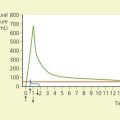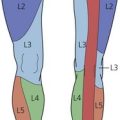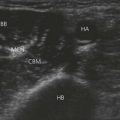CHAPTER 2 Regional anesthesia in perspective
history, current role, and the future
The doctrine of specific energies of the senses, proclaimed by Johannes P. Mueller (1801–58) in 1826 – that it is the nerves that determine what the mind perceives – opened up a new field of scientific thought and research into nerve function.1 This led directly to the theory that pain is a separate and distinct sense, formulated by Moritz S. Schiff (1823–96) in 1858.2 Yet by 1845, Sir Francis Rynd (1801–61) had already delivered a morphine solution to a nerve for the purpose of relieving intractable neuralgia (Box 2.1).3 This appears to be the first documented nerve block as we understand the term today. Rynd, however, delivered his solution by means of gravity through a cannula. The first use of a syringe and hypodermic needle was not recorded until 10 years later, in 1855, by Alexander Wood (1817–84) in Edinburgh.4 Wood used a graduated glass syringe and needle to achieve the same end as Rynd.
Carl Koller (1857–1944) was an intern at the Ophthalmologic Clinic at the University of Vienna in 1884. He was searching for a topical local anesthetic and, on the advice of Sigmund Freud (1856–1939), studied cocaine. Following self-experimentation, Koller performed an operation for glaucoma under topical anesthesia on September 11, 1884. He immediately wrote a paper for the Congress of Ophthalmology (held on September 15 of that year), which was published soon after in the Lancet.5 The remarkable effectiveness of cocaine as an anesthetic agent led to its immediate widespread use in this area.6,7
In the same year as Koller’s achievement, 1884, William Stewart Halsted (1852–1922) performed the first documented brachial plexus anesthetic under direct vision at Johns Hopkins,8 although it was 1911 before Hirschel and Kulenkampff performed the first percutaneous axillary and supraclavicular brachial plexus blocks.9,10 By the 1890s, Carl Ludwig Schleich (1859–1922) in Germany and Paul Reclus (1847–1914) in France were seriously writing on the subject of infiltration anesthesia, first with water and later with weak solutions of cocaine.11,12
Anesthesia as a specialty had not yet developed at this stage, because the surgeon infiltrated as he operated. Victor Pauchet (1869–1936) was the first to point out a new technique of regional anesthesia in which the procedure was carried out by an assistant in advance. In his 1914 textbook L’Anesthésie Régionale, the first of its kind, he stated that he had witnessed Reclus’s technique at first hand 25 years before, and now wished to emphasize the novel concept of regional anesthesia and the emergence of anesthesia or anesthesiology as a specialty.13
Sydney Ormond Goldan (1869–1944), describing himself as an anesthetist, had published the first anesthesia chart in 1900.14 It was designed for monitoring the course of ‘intraspinal cocainization’ and helped lay the foundation for the careful record-keeping that is a cornerstone of modern anesthesia.
Gaston Labat (1876–1934) worked and trained under Pauchet in France in 1917–18.15 He learned much from treating the casualties of World War I, and in 1922 published the first edition of Regional Anesthesia: Techniques and Clinical Applications, one of the first English-language texts on the subject.16 Many of his illustrations and techniques continue to have relevance today.
On September 29, 1920, Labat arrived at the Mayo Clinic, Rochester, Minnesota, to teach regional anesthesia to the clinic’s surgeons. From his brief 9-month period there and following tenure at Bellevue Hospital, New York University, he was to have a major influence on the development of the specialty of anesthesia in the USA.17 His influence on practitioners such as John Lundy, Ralph Waters, and Emory Rovenstine – pioneers in the development of the specialty – was substantial, and the American Society of Regional Anesthesia was initially to have been named after him.18
The American Board of Anesthesiology was formed in 1938 and held its first written examinations in March 1939. Here, Labat’s legacy continued. In the anatomy section all five questions related to regional anesthesia blocks; two of the five pharmacology questions dealt with local anesthetics in regional anesthesia; and one of the pathology questions dealt with regional anesthesia.19
Developments continued in the subspecialty through the 20th century (see Box 2.2) to the point where, in 1980, a survey of American anesthesiology residency programs reported the use of regional anesthesia in 21.3% of cases, in 1990 in 29.8% of cases, and in 2000 in 30.2% of cases.20–22 The majority of these cases, however, involve obstetric anesthesia or pain medicine, which has raised concern in some quarters as to the future place of peripheral nerve blockade in peri-operative anesthetic practice. This future, indeed, may lie in the areas of acute pain management and patient satisfaction.
Box 2.2
Development of regional anesthesia
| 1826 | Mueller: doctrine of specific energies of the senses |
| 1845 | Rynd: first nerve block |
| 1855 | Wood: needle and syringe |
| 1858 | Schiff: pain defined as a specific sense |
| 1884 | Koller: cocaine used for topical anesthesia |
| Halsted: first brachial plexus block | |
| 1890 | Schleich & Reclus: infiltration anesthesia |
| 1900 | Goldan: anesthesia charts |
| 1911 | Hirschel & Kulenkampff: percutaneous brachial plexus block |
| Stoffel: galvanic current applied to nerve | |
| 1914 | Pauchet: L’Anésthesie Régionale |
| 1922 | Labat: Regional Anesthesia: Techniques and Clinical Applications |
| 1923 | American Society of Regional Anesthesia founded |
| 1930 | Labat: posterior approach to the stellate ganglion |
| 1939 | Rovenstine & Wertheim: cervical plexus block |
| 1940 | Patrick: current supraclavicular brachial plexus technique |
| 1946 | Ansboro: continuous brachial plexus block |
| 1954 | Moore: paratracheal approach to stellate ganglion |
| 1958 | Burnham: axillary brachial plexus perivascular technique |
| 1964 | Winnie & Collins: subclavian brachial plexus block |
| 1970 | Winnie: interscalene brachial plexus block |
| 1973 | Montgomery, Raj: nerve stimulator in contemporary practice |
| 1993 | Collum, Courtney: lateral popliteal approach to the sciatic nerve |
| 1995 | Kilka: vertical infraclavicular brachial plexus block |
Continuous peripheral nerve blocks using catheters have been in use since 1946.23 They have been shown to provide effective postoperative analgesia, be opioid-sparing, and result in improved rehabilitation and high patient satisfaction.24–26 With refining of the techniques over the intervening half-century, a number of clinicians have used them with great effectiveness. To date, however, their use has been largely confined to inpatients because worries about motor weakness, patient injury, catheter migration, and local anesthetic toxicity have persisted. Concurrently, up to 70 or 80% of patients complain of severe pain following ambulatory surgery, requiring continued opioid medication for up to a week in many cases.27,28
In the early 2000s, a number of authors reported the use of continuous peripheral nerve catheters in the ambulatory setting with a high degree of success, few complications, and good levels of patient acceptance and satisfaction.29–32 As these techniques are still in their infancy, a number of special precautions were taken in these studies to ensure safety in the home environment. In addition, as the early pioneers had to defend their practice, it is certain these new pioneers will have to do likewise with these new developments. Further research will likely define the indications and limitations of this technology.
Long-acting peripheral nerve block has been used with a high degree of efficacy, safety, and satisfaction in the ambulatory setting, and is practiced by many anesthetists.33,34 Single-injection extended-duration (72h) local anesthetic agents have been heralded for many years.35 When, and if, they become a reality we may see a rapid expansion in the use of regional anesthetic techniques as well as the resurrection of the original infiltration techniques as practiced by Schleich and Reclus.
The concept of patient satisfaction has been often dismissed as a parameter too difficult to measure. Unfortunately, the lack of an accepted model of patient satisfaction has hindered progress.36 In recent years, however, a few authors have described the development of global measurement tools and psychometrically constructed questionnaires that produce reliable results; these tools have been applied prospectively in large patient populations.37,38 Parameters such as improved pain relief and reduced postoperative nausea and vomiting are some of the factors influenced positively by regional anesthesia, and these are also indicators of high patient satisfaction. It can be said that patient satisfaction has become an important indicator of quality of medical care and an important endpoint in outcomes research.39
1 Riese W, Arrington GEJr. The history of Johannes Muller’s doctrine of the specific energies of the senses: original and later versions. Bull Hist Med. 1963;37:179-183.
2 Dallenbach KM. Pain: history and present status. Am J Psychol. 1939;52:331.
3 Rynd F. Neuralgia – introduction of fluid to the nerve. Dublin Med Press. 1845;13:167-168.
4 Wood A. New method of treating neuralgia by the direct application of opiates to the painful points. Edinb Med Surg J. 1855;82:265-281.
5 Koller C. On the use of cocaine for producing anaesthesia on the eye. Lancet. 1884;2:990-992.
6 Hepburn NJ. Some notes on hydrochlorate of cocaine. Med Rec (NY). 1884;26:534.
7 Bull CS. The hydrochlorate of cocaine as a local anaesthetic in ophthalmic surgery. NY Med J. 1884;40:609-612.
8 Halsted WS. Surgical papers. Baltimore: Johns Hopkins Press; 1925.
9 Hirschel G. Anaesthesia of the brachial plexus for operations on the upper extremity. Med Wochenschr. 1911;5:1555-1960.
10 Kulenkampff D. Die Anasthesia des plexus brachialis. Zentralbl Chir. 1911;38:1337.
11 Schleich CL. Zur Infiltrations anasthesie. Therapeutisch Monatshefte. 1894;8:429.
12 Reclus P. Analgésie locale par la cocaine. Rev Chir. 1889;9:913-916.
13 Pauchet V, Sourdat P. L’Anésthesie Régionale. Paris: Octave Doin et Fils, Editeurs; 1914.
14 Goldan SO. Intraspinal cocainization for surgical anaesthesia. Phila Med J. 1900;6:850-853.
15 Brown DL, Winnie AP. Biography of Louis Gaston Labat, MD. Reg Anesth. 1992;22:218-222.
16 Labat G. Regional anesthesia: techniques and clinical applications. Philadelphia: WB Saunders; 1922.
17 Bacon RD, Gaston Labat, John Lundy, Emery Rovenstine, and the Mayo Clinic. The spread of regional anesthesia in America between the World Wars. J Clin Anesth. 2002;14:315-320.
18 Betcher AM, Ciliberti PM, Wood PM, et al. The jubilee year of organized anesthesia. Anesthesiology. 1956;17:226-264.
19 Bacon DR, Darwish H, Emory A. To define a specialty: a brief history of the American Board of Anesthesiology’s first written examination. J Clin Anesth. 1992;4:489-497.
20 Bridenbaugh L. Are anesthesia resident programs failing regional anesthesia? Reg Anesth. 1982;7:26-28.
21 Kopacz DJ, Bridenbaugh LD. Are anesthesia residency programs failing regional anesthesia? The past, present, and future. Reg Anesth. 1993;18:84-87.
22 Kopacz DJ, Neal JM. Regional anesthesia and pain medicine: residency training–the year 2000. Reg Anesth Pain Med. 2002;27:9-14.
23 Ansboro F. Method of continuous brachial plexus block. Am J Surg. 1946;71:716-722.
24 Selander D. Catheter technique in axillary plexus block. Acta Anaesth Scand. 1977;21:324-329.
25 Dahl J, Christiansen C, Daugaard J, et al. Continuous blockade of the lumbar plexus after knee surgery–postoperative analgesia and bupivacaine plasma concentrations. A controlled clinical trial. Anaesthesia. 1988;43:1015-1018.
26 Capdevila X, Barthelet Y, Biboulet P, et al. Effects of perioperative analgesic technique on the surgical outcome and duration of rehabilitation after major knee surgery. Anesthesiology. 1999;91:8-15.
27 Chung F, Mezei G. Adverse outcomes in ambulatory anesthesia. Can J Anesth. 1999;46:R18-R26.
28 McHugh GA, Thoms GMM. The management of pain following day-case surgery. Anaesthesia. 2002;57:270-275.
29 Ilfeld B, Morey T, Enneking F. Continuous infraclavicular block for postoperative pain control at home: a randomized double-blind placebo-controlled study. Anesthesiology. 2002;96:1297-1304.
30 Ilfeld BM, Morey TE, Wang DR, et al. Continuous popliteal sciatic nerve block for postoperative pain control at home: a randomized, double-blinded, placebo-controlled study. Anesthesiology. 2002;97:959-965.
31 Rawal N, Allvin R, Axelsson K, et al. Patient-controlled regional analgesia (PCRA) at home. Controlled comparison between bupivacaine and ropivacaine brachial plexus analgesia. Anesthesiology. 2002;96:1290-1296.
32 Grant SA, Nielsen KC, Greengrass RA, et al. Continuous peripheral nerve block for ambulatory surgery. Reg Anesth Pain Med. 2001;26:209-214.
33 Klein SM, Nielsen KC, Greengrass RA, et al. Ambulatory discharge after long-acting peripheral nerve blockade: 2382 blocks with ropivacaine. Anesth Analg. 2002;94:65-70.
34 Klein SM, Pietrobon R, Nielsen KC, et al. Peripheral nerve blockade with long-acting local anesthetics: a survey of the Society for Ambulatory Anesthesia. Anesth Analg. 2002;94:71-76.
35 Klein SM. Beyond the hospital: continuous peripheral nerve blocks at home [editorial]. Anesthesiology. 2002;96:1283-1285.
36 Wu CL, Naqibuddin M, Fleischer LA. Measurement of patient satisfaction as an outcome of regional anesthesia and analgesia: a systematic review. Reg Anesth Pain Med. 2001;26:196-208.
37 Myles PS, Williams DL, Hendrata M, et al. Patient satisfaction after anaesthesia and surgery: results of a prospective study of 10,811 patients. Br J Anaesth. 2000;84:6-10.
38 Tong D, Chung F, Wong D. Predictive factors in global and anesthesia satisfaction in ambulatory surgical patients. Anesthesiology. 1997;87:856-864.
39 Schug SA. Patient satisfaction–politically correct fashion of the nineties or a valuable measure of outcome? Reg Anesth Pain Med. 2001;26:193-195.







